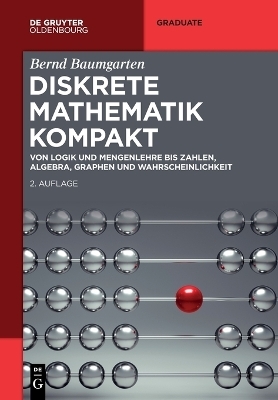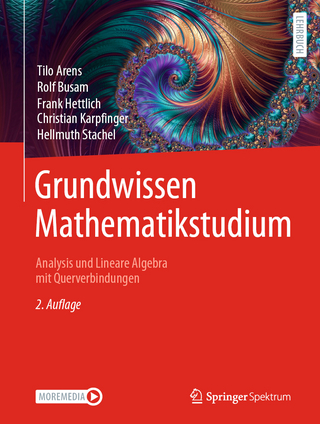
Applications of Hyperstructure Theory
Seiten
2003
Springer-Verlag New York Inc.
978-1-4020-1222-8 (ISBN)
Springer-Verlag New York Inc.
978-1-4020-1222-8 (ISBN)
Presents various applications of hyperstructures. There are applications to the following subjects: geometry; hypergraphs; binary relations; lattices; fuzzy sets and rough sets; automata; cryptography; median algebras, relation algebras; combinatorics; codes; artificial intelligence; probabilities. This work is useful for students and researchers.
Some mathematical disciplines can be presented and developed in the context of other disciplines, for instance Boolean algebras, that Stone has converted in a branch of ring theory, projective geome- tries, characterized by Birkhoff as lattices of a special type, projec- tive, descriptive and spherical geometries, represented by Prenowitz, as multigroups, linear geometries and convex sets presented by Jan- tosciak and Prenowitz as join spaces. As Prenowitz and Jantosciak did for geometries, in this book we present and study several ma- thematical disciplines that use the Hyperstructure Theory. Since the beginning, the Hyperstructure Theory and particu- larly the Hypergroup Theory, had applications to several domains. Marty, who introduced hypergroups in 1934, applied them to groups, algebraic functions and rational fractions. New applications to groups were also found among others by Eaton, Ore, Krasner, Utumi, Drbohlav, Harrison, Roth, Mockor, Sureau and Haddad. Connections with other subjects of classical pure Mathematics have been determined and studied: * Fields by Krasner, Stratigopoulos and Massouros Ch.
* Lattices by Mittas, Comer, Konstantinidou, Serafimidis, Leoreanu and Calugareanu * Rings by Nakano, Kemprasit, Yuwaree * Quasigroups and Groupoids by Koskas, Corsini, Kepka, Drbohlav, Nemec * Semigroups by Kepka, Drbohlav, Nemec, Yuwaree, Kempra- sit, Punkla, Leoreanu * Ordered Structures by Prenowitz, Corsini, Chvalina IX x * Combinatorics by Comer, Tallini, Migliorato, De Salvo, Scafati, Gionfriddo, Scorzoni * Vector Spaces by Mittas * Topology by Mittas , Konstantinidou * Ternary Algebras by Bandelt and Hedlikova.
Some mathematical disciplines can be presented and developed in the context of other disciplines, for instance Boolean algebras, that Stone has converted in a branch of ring theory, projective geome- tries, characterized by Birkhoff as lattices of a special type, projec- tive, descriptive and spherical geometries, represented by Prenowitz, as multigroups, linear geometries and convex sets presented by Jan- tosciak and Prenowitz as join spaces. As Prenowitz and Jantosciak did for geometries, in this book we present and study several ma- thematical disciplines that use the Hyperstructure Theory. Since the beginning, the Hyperstructure Theory and particu- larly the Hypergroup Theory, had applications to several domains. Marty, who introduced hypergroups in 1934, applied them to groups, algebraic functions and rational fractions. New applications to groups were also found among others by Eaton, Ore, Krasner, Utumi, Drbohlav, Harrison, Roth, Mockor, Sureau and Haddad. Connections with other subjects of classical pure Mathematics have been determined and studied: * Fields by Krasner, Stratigopoulos and Massouros Ch.
* Lattices by Mittas, Comer, Konstantinidou, Serafimidis, Leoreanu and Calugareanu * Rings by Nakano, Kemprasit, Yuwaree * Quasigroups and Groupoids by Koskas, Corsini, Kepka, Drbohlav, Nemec * Semigroups by Kepka, Drbohlav, Nemec, Yuwaree, Kempra- sit, Punkla, Leoreanu * Ordered Structures by Prenowitz, Corsini, Chvalina IX x * Combinatorics by Comer, Tallini, Migliorato, De Salvo, Scafati, Gionfriddo, Scorzoni * Vector Spaces by Mittas * Topology by Mittas , Konstantinidou * Ternary Algebras by Bandelt and Hedlikova.
Basic notions and results on Hyperstructure Theory.- 1 Some topics of Geometry.- 2 Graphs and Hypergraphs.- 3 Binary Relations.- 4 Lattices.- 5 Fuzzy sets and rough sets.- 6 Automata.- 7 Cryptography.- 8 Codes.- 9 Median algebras, Relation algebras, C-algebras.- 10 Artificial Intelligence.- 11 Probabilities.
| Erscheint lt. Verlag | 31.3.2003 |
|---|---|
| Reihe/Serie | Advances in Mathematics ; 5 |
| Zusatzinfo | XII, 322 p. |
| Verlagsort | New York, NY |
| Sprache | englisch |
| Maße | 155 x 235 mm |
| Themenwelt | Mathematik / Informatik ► Mathematik |
| ISBN-10 | 1-4020-1222-5 / 1402012225 |
| ISBN-13 | 978-1-4020-1222-8 / 9781402012228 |
| Zustand | Neuware |
| Haben Sie eine Frage zum Produkt? |
Mehr entdecken
aus dem Bereich
aus dem Bereich
Von Logik und Mengenlehre bis Zahlen, Algebra, Graphen und …
Buch | Softcover (2024)
De Gruyter Oldenbourg (Verlag)
74,95 €
Analysis und Lineare Algebra mit Querverbindungen
Buch | Hardcover (2022)
Springer Spektrum (Verlag)
64,99 €
Versteckte Beiträge, die die Welt verändert haben
Buch | Hardcover (2023)
Springer (Verlag)
29,99 €


